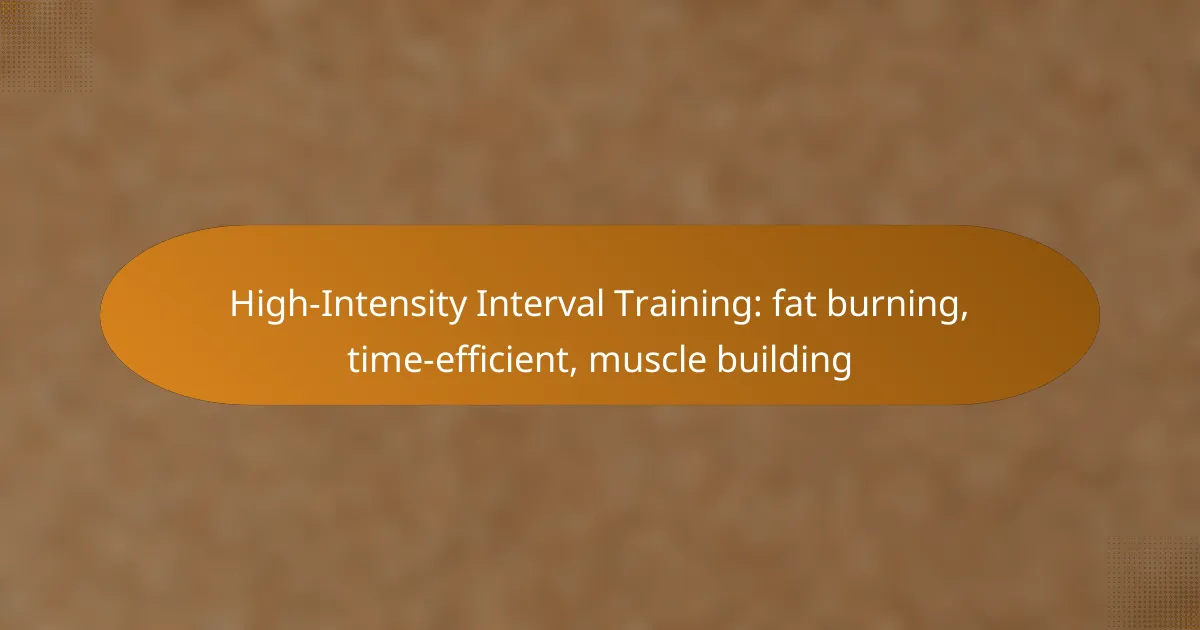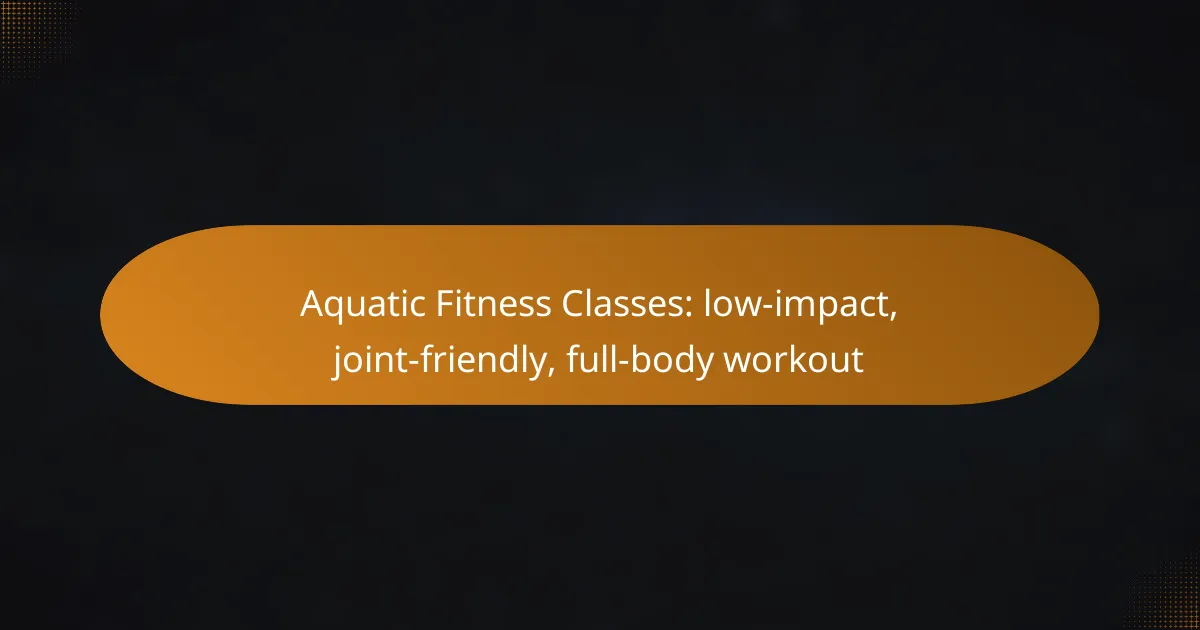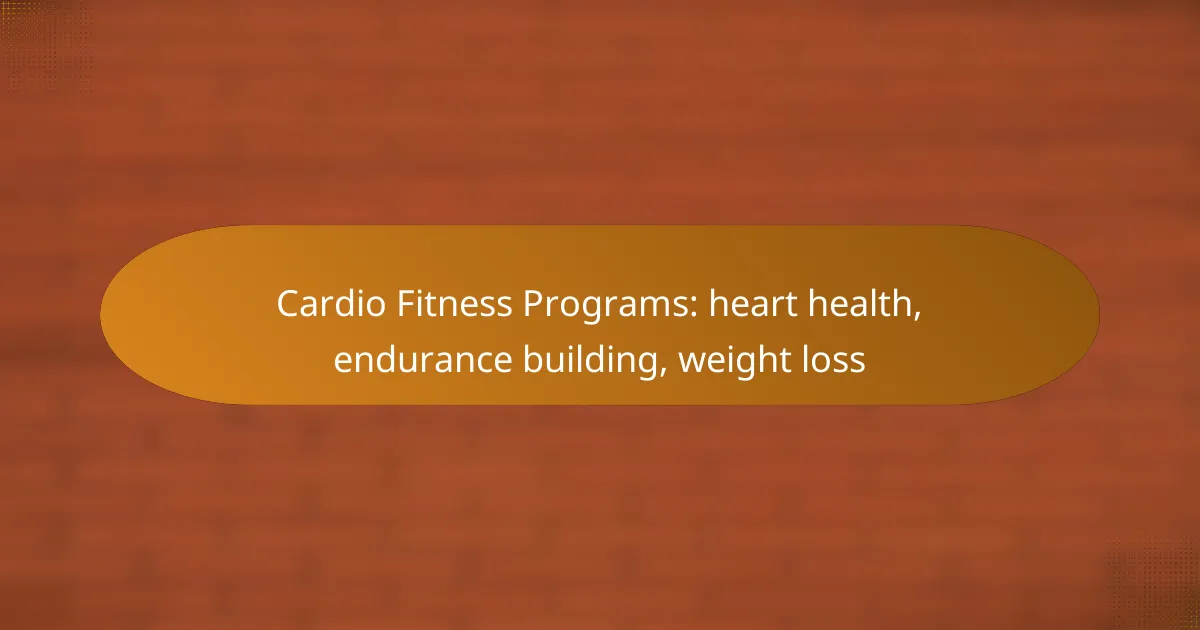High-Intensity Interval Training (HIIT) is a powerful workout method that combines short bursts of intense exercise with rest periods, making it highly effective for fat burning and muscle building. This time-efficient approach not only elevates your metabolic rate, leading to increased calorie expenditure, but also promotes muscle growth through increased workload and metabolic stress. With HIIT, you can achieve significant fitness results in a fraction of the time compared to traditional workouts.

How does High-Intensity Interval Training help with fat burning?
High-Intensity Interval Training (HIIT) is effective for fat burning due to its ability to elevate the metabolic rate and enhance calorie expenditure in a short time. By alternating between intense bursts of activity and rest, HIIT maximizes fat loss while building muscle, making it a time-efficient workout option.
Increased metabolic rate
HIIT significantly boosts the metabolic rate during and after workouts. This increase can lead to higher calorie burn even when at rest, as the body continues to consume energy to recover. Studies suggest that metabolic rates can remain elevated for hours post-exercise, contributing to overall fat loss.
To maximize this effect, incorporate HIIT sessions into your routine at least two to three times a week. This frequency allows for recovery while still promoting metabolic benefits.
Enhanced calorie burn during workouts
During HIIT workouts, participants can burn more calories in a shorter period compared to traditional steady-state cardio. For example, a 20-minute HIIT session can burn a similar amount of calories as a 40-minute moderate-intensity workout. This efficiency is particularly beneficial for those with limited time.
To enhance calorie burn, focus on exercises that engage multiple muscle groups, such as burpees, jump squats, or kettlebell swings. Aim for a work-to-rest ratio of about 1:1 or 2:1 to maintain intensity.
Post-exercise oxygen consumption
One of the key benefits of HIIT is the phenomenon known as excess post-exercise oxygen consumption (EPOC). After intense workouts, the body requires additional oxygen to restore itself, which translates to continued calorie burning. This effect can last several hours, further aiding fat loss.
To take advantage of EPOC, ensure your HIIT sessions are challenging enough to push your limits. Incorporate varied intervals and high-intensity exercises to maximize oxygen consumption and fat burning after your workout.
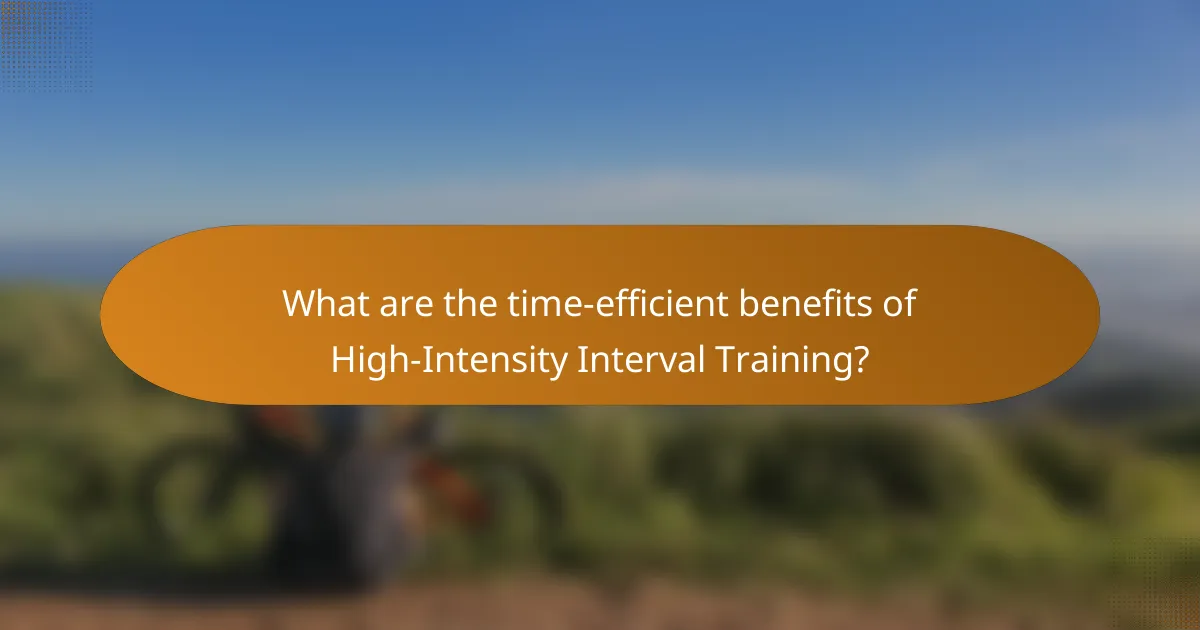
What are the time-efficient benefits of High-Intensity Interval Training?
High-Intensity Interval Training (HIIT) offers significant time-efficient benefits, allowing individuals to achieve effective workouts in shorter durations. By alternating between intense bursts of activity and brief recovery periods, HIIT maximizes calorie burn and muscle engagement within limited time frames.
Shorter workout durations
HIIT workouts typically last between 15 to 30 minutes, making them ideal for busy schedules. Unlike traditional workouts that may require an hour or more, HIIT can deliver similar or even superior results in a fraction of the time.
For example, a 20-minute HIIT session can consist of 30 seconds of intense exercise followed by 30 seconds of rest, repeated for several rounds. This structure keeps the heart rate elevated while minimizing time spent exercising.
Effective results in minimal time
The effectiveness of HIIT lies in its ability to boost metabolism and enhance fat burning even after the workout is complete. Research suggests that HIIT can lead to significant improvements in cardiovascular fitness and muscle strength, often within a few weeks of consistent training.
To maximize results, aim for 2 to 3 HIIT sessions per week, incorporating a variety of exercises like sprints, cycling, or bodyweight movements. This approach not only saves time but also keeps workouts engaging and challenging.
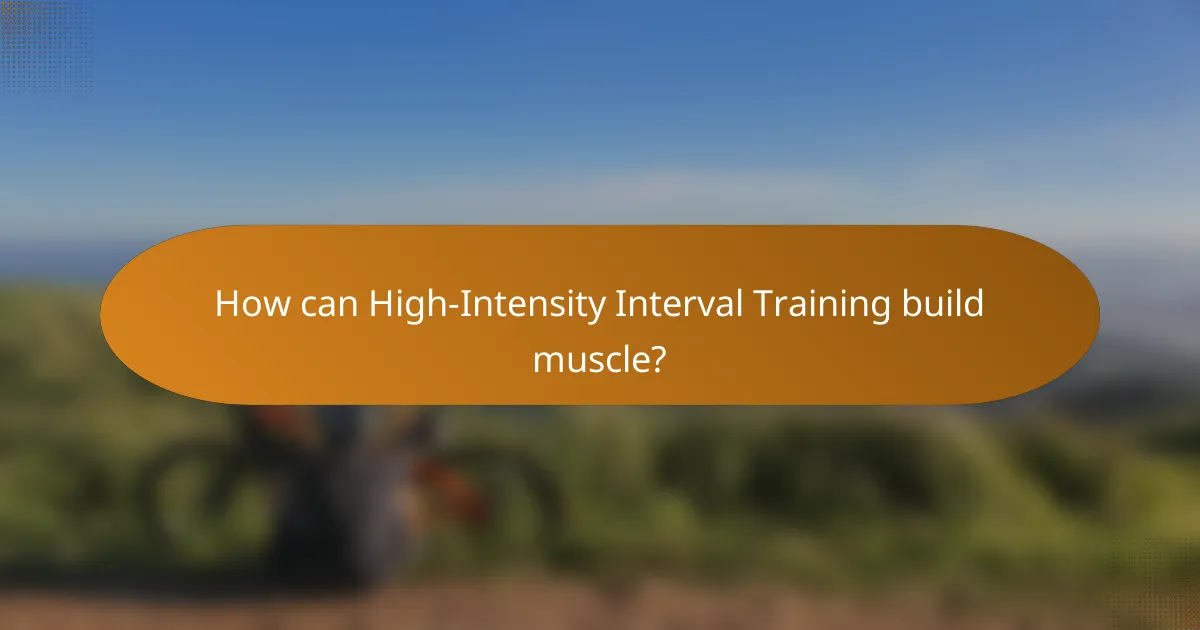
How can High-Intensity Interval Training build muscle?
High-Intensity Interval Training (HIIT) can effectively build muscle by combining short bursts of intense exercise with rest or low-intensity periods. This approach stimulates muscle growth and strength through increased workload and metabolic stress.
Increased muscle hypertrophy
HIIT promotes muscle hypertrophy by engaging multiple muscle groups at high intensity, leading to greater muscle fiber recruitment. This type of training often involves compound movements like squats and deadlifts, which can maximize muscle growth in a shorter time frame.
To achieve optimal hypertrophy, aim for sessions that include 20-30 seconds of intense effort followed by equal or slightly longer rest periods. This method can be repeated for several rounds, typically 4-8, depending on your fitness level and goals.
Improved strength gains
HIIT can lead to improved strength gains by enhancing both muscular endurance and power. The high intensity of the workouts forces muscles to adapt quickly, resulting in increased strength over time.
Incorporate strength-focused exercises, such as kettlebell swings or push-ups, into your HIIT routine. Aim for a mix of bodyweight and weighted movements, adjusting the load to ensure you can maintain proper form while pushing your limits. Regularly changing your HIIT routine can also help prevent plateaus and keep strength gains progressing.

What are the best High-Intensity Interval Training workouts?
The best High-Intensity Interval Training (HIIT) workouts are those that maximize fat burning and muscle building in a short amount of time. Popular options include Tabata training, circuit training, and bodyweight HIIT routines, each offering unique benefits and structures.
Tabata training
Tabata training is a specific form of HIIT that follows a 20 seconds on, 10 seconds off format, repeated for eight rounds, totaling four minutes. This method is effective for improving both aerobic and anaerobic fitness while burning calories quickly.
To implement Tabata, choose an exercise like burpees or squats, and perform it at maximum intensity during the work intervals. Ensure proper form to avoid injury, and consider starting with one or two Tabata rounds before progressing to more.
Circuit training
Circuit training combines various exercises performed in sequence with minimal rest, targeting different muscle groups. This approach allows for a full-body workout that can enhance strength and endurance while keeping the heart rate elevated.
Typically, a circuit includes 5-10 exercises, such as push-ups, lunges, and kettlebell swings, with each exercise lasting 30 seconds to a minute. Aim for 2-4 circuits per session, adjusting the rest time between circuits based on your fitness level.
Bodyweight HIIT routines
Bodyweight HIIT routines utilize your own weight for resistance, making them accessible and versatile. These workouts can be done anywhere and often include exercises like jumping jacks, mountain climbers, and planks.
To create an effective bodyweight HIIT session, select 4-6 exercises and perform each for 30 seconds, followed by 15 seconds of rest. Repeat the circuit for 3-5 rounds, focusing on maintaining high intensity throughout to maximize fat burning and muscle engagement.
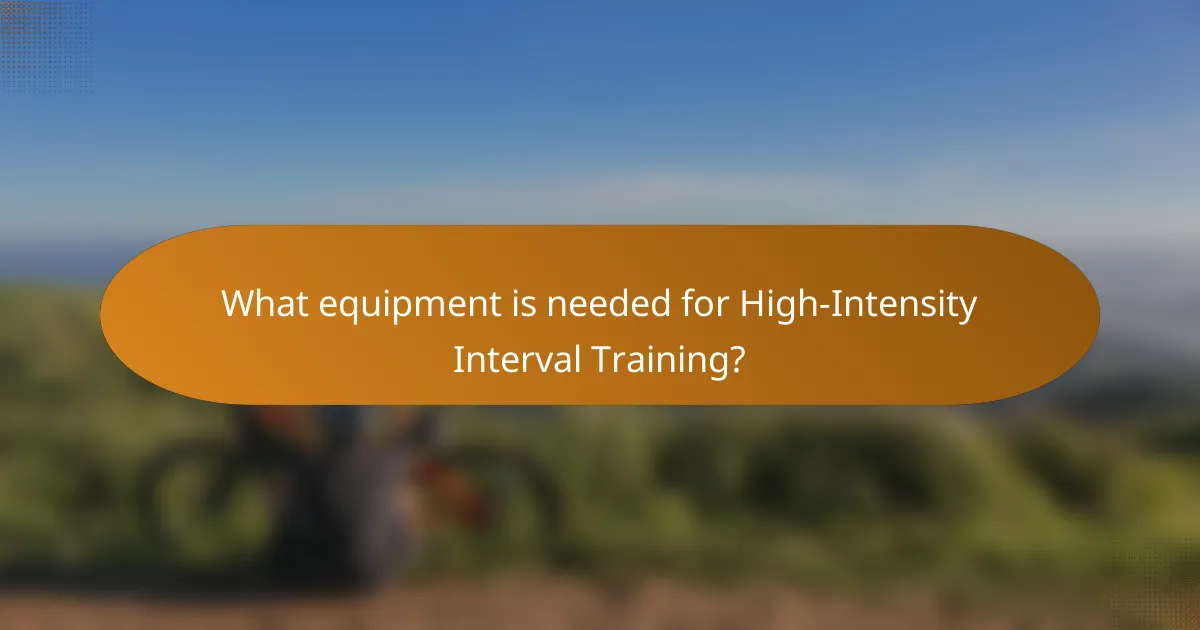
What equipment is needed for High-Intensity Interval Training?
High-Intensity Interval Training (HIIT) can be performed with minimal equipment, making it accessible for many. Essential tools include dumbbells, kettlebells, and resistance bands, each offering unique benefits for fat burning, muscle building, and time efficiency.
Dumbbells
Dumbbells are versatile and can be used for a variety of exercises in HIIT routines. They allow for targeted muscle engagement and can be adjusted in weight to match your fitness level.
When selecting dumbbells, consider starting with a range between 5 to 25 pounds, depending on your strength. Incorporating movements like dumbbell thrusters or renegade rows can enhance your workout’s intensity.
Kettlebells
Kettlebells are excellent for dynamic movements that combine strength and cardio, making them ideal for HIIT. Their unique shape allows for a variety of swinging and lifting exercises that engage multiple muscle groups.
Choose kettlebells weighing between 10 to 35 pounds for effective workouts. Exercises like kettlebell swings and goblet squats can significantly boost your heart rate while building muscle.
Resistance bands
Resistance bands are lightweight and portable, making them perfect for HIIT workouts at home or on the go. They provide constant tension throughout movements, which can enhance muscle activation.
Look for bands with varying resistance levels, typically ranging from light to heavy. Incorporating exercises like banded squats or lateral walks can effectively target different muscle groups while keeping your heart rate elevated.
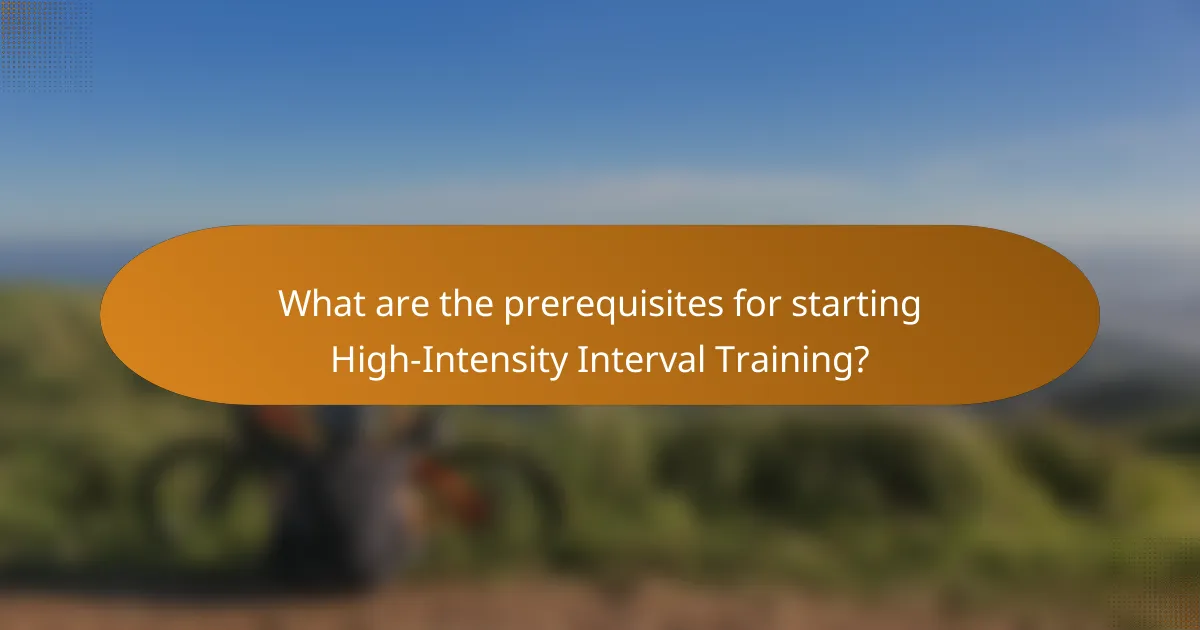
What are the prerequisites for starting High-Intensity Interval Training?
Before starting High-Intensity Interval Training (HIIT), it’s essential to assess your fitness level and consult with a healthcare provider. These steps ensure that you can safely engage in this demanding workout style while minimizing the risk of injury.
Basic fitness level
A basic fitness level is crucial for anyone considering HIIT. If you’re new to exercise, it’s advisable to build a foundation with moderate aerobic activities, such as walking or cycling, for several weeks. This preparation helps your body adapt to increased intensity.
For those with some experience, evaluate your current endurance and strength. You should be comfortable performing exercises like push-ups, squats, and jogging for short periods. Aim for a fitness level that allows you to sustain moderate activity for at least 20-30 minutes before progressing to HIIT.
Consultation with a healthcare provider
Consulting with a healthcare provider is a vital step before starting HIIT, especially if you have pre-existing health conditions or concerns. A medical professional can assess your overall health and provide personalized recommendations based on your medical history.
During the consultation, discuss any symptoms you may experience during exercise, such as chest pain or shortness of breath. This information will help your provider determine if HIIT is suitable for you or if modifications are necessary to ensure your safety while exercising.
